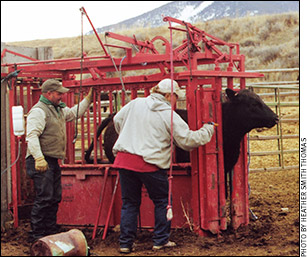To the Point
Keep these BQA tips in mind when vaccinating.
“Adequate restraint is very important when vaccinating,” says Nora Schrag, veterinarian with the Kansas State University College of Veterinary Medicine. “I personally have filled an alleyway with cattle, and vaccinated them without catching heads. This can work fine in the right facility, as long as we keep in mind Beef Quality Assurance (BQA) criteria. We need to be injecting into the neck, and if this is not possible in the alleyway, we need to be catching them,” she says.
Broken needles are a concern when cattle are not properly restrained. Schrag recommends using a short needle as it is less apt to bend or break. Most vaccinations today are given by subcutaneous (SubQ) injections, which can be given with a very short needle.

Proper restraint is important to get the vaccine in the right place. The adverse reaction rate to vaccination goes up drastically if people accidentally inject directly into a blood vessel.
“We like to use a 16-gauge, ⅝-inch needle, which makes it almost impossible to get it into the muscle, even if the animal moves. It will end up in the right place, and that needle isn’t likely to break, because it’s big enough and short enough,” she explains.
Depending on the brand, she says some reproductive vaccines — like those to prevent leptospirosis — are still labeled for intramuscular (IM) injection. Then, a 1-inch (in.) needle could be used. Schrag adds that 1-in., 16-gauge needles are more durable than longer, smaller needles.
If a needle breaks off in an animal, this is a food safety issue and a cattle health issue.
“If this happens, stop that animal right where it is, mark the spot, call a veterinarian, and see if they can get it out. If they can’t get it out, that animal cannot enter the food chain,” she explains.
Proper restraint is important to get the vaccine in the right place. The adverse reaction rate to vaccination goes up drastically if people accidentally inject directly into a blood vessel.
“The most frequent time we see this is when people are roping and dragging calves, and injecting into the neck of the roped calf. If you get a little bit too low, it may go right into the calf’s jugular vein. On a little calf, a couple inches can put it right into the jugular vein,” she says.
“This can even happen in a chute if the calf is bouncing around and turns his head. You might inject where you normally do, but his neck is now sideways. Just keep in mind that there’s a jugular vein down there at the lower part of the neck and make sure you are staying away from that area,” cautions Schrag.
It’s wise to change needles periodically, even if the needle you are using is not yet dull or bent. She suggests that seedstock operations trying to control leukosis or other blood-borne diseases should change needles for every animal. Using a separate, sterile needle for each animal is a cheap means of insurance for breeding stock.
For commercial cattle and feeder calves, she recommends changing the needle every 10 to 15 head. However, if the needle has dulled from a slight burr on the tip, it will cause more pain and tissue damage. It should be changed whenever that occurs. Schrag suggests changing needles each time you refill a multi-dose syringe gun.
Always try to vaccinate into a clean area on the animal. Sometimes when they are waiting their turn in the runway, cattle can get manure on their head and neck from the animal in front. “We want to vaccinate into the triangular area of the neck, but sometimes we have to move to the other side that’s cleaner. If the neck is dirty on both sides, you may have to put a subcutaneous injection under the loose skin behind the shoulder,” she says.
“When people rope and brand calves, this is actually an easier spot to vaccinate the calf than in the neck. Someone usually has their leg on the neck, holding the calf on the ground. It’s safer for both the calf and the human to inject over the ribs.” This injection site is not a meat quality issue.

Editor’s Note: Heather Smith Thomas is a freelance writer and cattlewoman from Salmon, Idaho.





